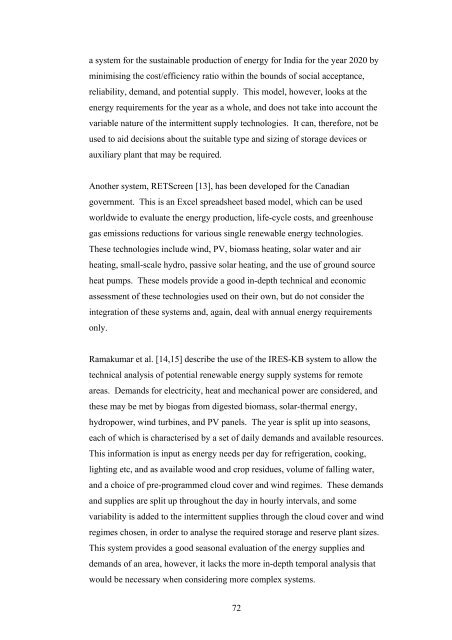PhD Thesis - Energy Systems Research Unit - University of Strathclyde
PhD Thesis - Energy Systems Research Unit - University of Strathclyde
PhD Thesis - Energy Systems Research Unit - University of Strathclyde
Create successful ePaper yourself
Turn your PDF publications into a flip-book with our unique Google optimized e-Paper software.
a system for the sustainable production <strong>of</strong> energy for India for the year 2020 by<br />
minimising the cost/efficiency ratio within the bounds <strong>of</strong> social acceptance,<br />
reliability, demand, and potential supply. This model, however, looks at the<br />
energy requirements for the year as a whole, and does not take into account the<br />
variable nature <strong>of</strong> the intermittent supply technologies. It can, therefore, not be<br />
used to aid decisions about the suitable type and sizing <strong>of</strong> storage devices or<br />
auxiliary plant that may be required.<br />
Another system, RETScreen [13], has been developed for the Canadian<br />
government. This is an Excel spreadsheet based model, which can be used<br />
worldwide to evaluate the energy production, life-cycle costs, and greenhouse<br />
gas emissions reductions for various single renewable energy technologies.<br />
These technologies include wind, PV, biomass heating, solar water and air<br />
heating, small-scale hydro, passive solar heating, and the use <strong>of</strong> ground source<br />
heat pumps. These models provide a good in-depth technical and economic<br />
assessment <strong>of</strong> these technologies used on their own, but do not consider the<br />
integration <strong>of</strong> these systems and, again, deal with annual energy requirements<br />
only.<br />
Ramakumar et al. [14,15] describe the use <strong>of</strong> the IRES-KB system to allow the<br />
technical analysis <strong>of</strong> potential renewable energy supply systems for remote<br />
areas. Demands for electricity, heat and mechanical power are considered, and<br />
these may be met by biogas from digested biomass, solar-thermal energy,<br />
hydropower, wind turbines, and PV panels. The year is split up into seasons,<br />
each <strong>of</strong> which is characterised by a set <strong>of</strong> daily demands and available resources.<br />
This information is input as energy needs per day for refrigeration, cooking,<br />
lighting etc, and as available wood and crop residues, volume <strong>of</strong> falling water,<br />
and a choice <strong>of</strong> pre-programmed cloud cover and wind regimes. These demands<br />
and supplies are split up throughout the day in hourly intervals, and some<br />
variability is added to the intermittent supplies through the cloud cover and wind<br />
regimes chosen, in order to analyse the required storage and reserve plant sizes.<br />
This system provides a good seasonal evaluation <strong>of</strong> the energy supplies and<br />
demands <strong>of</strong> an area, however, it lacks the more in-depth temporal analysis that<br />
would be necessary when considering more complex systems.<br />
72

















